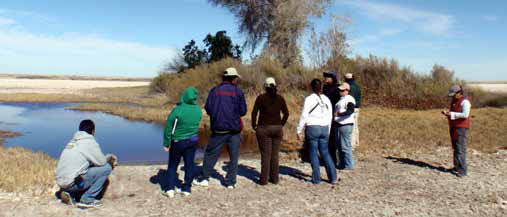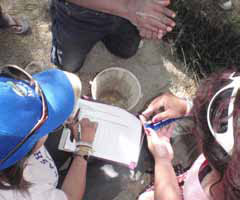 Fieldwork during the training workshop.
Fieldwork during the training workshop.(Photo: Kenia Castañeda Nevárez)
The training courses in biological monitoring provided an unequaled opportunity: the chance to camp and take a guided eco-trip into the hidden spaces of the Ciénaga de Santa Clara, a mangrove wetland in the Colorado River Delta, located in the city of San Luís Río Colorado.
The group of community monitors, composed of workers from CEDO (the Intercultural Center for the Study of Oceans and Deserts), the environmental group Pronatura and students from the Center for Marine Technology Studies (CETMar) No. 14 in Puerto Peñasco, were accompanied by Hitandehui Tovar, a biologist from CEDO.
The participants spent the night camping in cabañas built by the ejidatarios for that purpose, and while they enjoyed the marsh’s tranquility, the project’s leader shared anecdotes and explained how the project is being developed.
The following morning, after a chance to commune with nature, members of the work team put into practice what they had learned about monitoring birds.
Led by Alejandra Calvo and Eduardo Soto, they took a trip into the marsh, walking along an interpretive trail that was funded by the UN.
They marveled at the surrounding environment and encountered signs along the way which pointed out important facts, such as the difference between resident and migratory birds.
 Fieldwork during the training workshop.
Fieldwork during the training workshop.The courses included lectures about the Upper Gulf of California and Colorado River Delta Biosphere Reserve. Among the topics covered in the lectures was the location of the reserve, which is divided between the states of Baja California and Sonora, passes through the municipalities of Mexicali, Puerto Peñasco y San Luís Río Colorado, and is less than 36 miles from the US border.
Administrative regulations as they apply to protected areas were also addressed, and included the Federal law Norma Oficial Mexicana (NOM) 059 from the Secretary of the Environment and Natural Resources (Semarnat), which protects various species found in the reserve.
Also discussed were conservation and management programs, which are themselves divided into sub-programs for: protection and monitoring; use of economical and sustainable technologies; wetland
The purpose of the event was to develop a conscious culture of conservation within the participants by having them learn directly from their positive, enjoyable interaction with nature.
It was about a beginning in passing on this type of knowledge to the community, in which it is stressed that sustainable development provides jobs in the protection of an environment that everyone has a stake in maintaining.
 Setting up camp at Lla Ciénega Santa Clara.
Setting up camp at Lla Ciénega Santa Clara. Students and teachers of CETMar 14 participate in the first Community Biological Monitoring Workshop.
Students and teachers of CETMar 14 participate in the first Community Biological Monitoring Workshop.The interpretive trail offers information about native species like the endangered Desert Pupfish (Cyprinodon macularius), as well as the environmental importance of the brackish wetland, which is the largest in the Sonoran Desert and provides invaluable benefits for both residents and visitors to the area.
At the end of the trip, the group visited Ejido Samuel Ocaña in what is commonly called La Pila, where hot water flows to the surface as natural springs that support an abundance of flora and fauna. After walking around the area for awhile, the group placed traps in the springs to catch some specimens of the Desert Pupfish, which is found only there.
And the value of the participation of students from our region in workshops given by these groups, such as the First Workshop on Community Biological Monitoring offered last January to students and teachers of the Center for Marine Technology Studies (CETMar) No. 14 in order to give them the tools necessary for monitoring both marine and terrestrial animals.